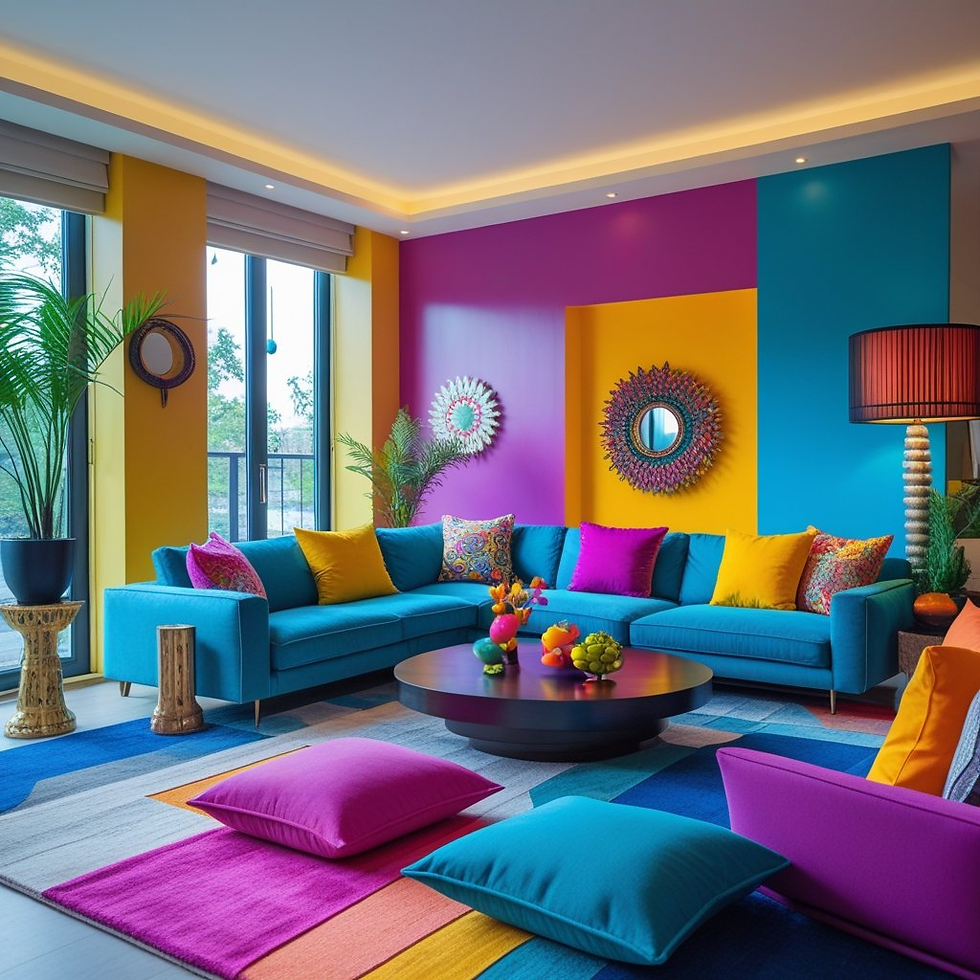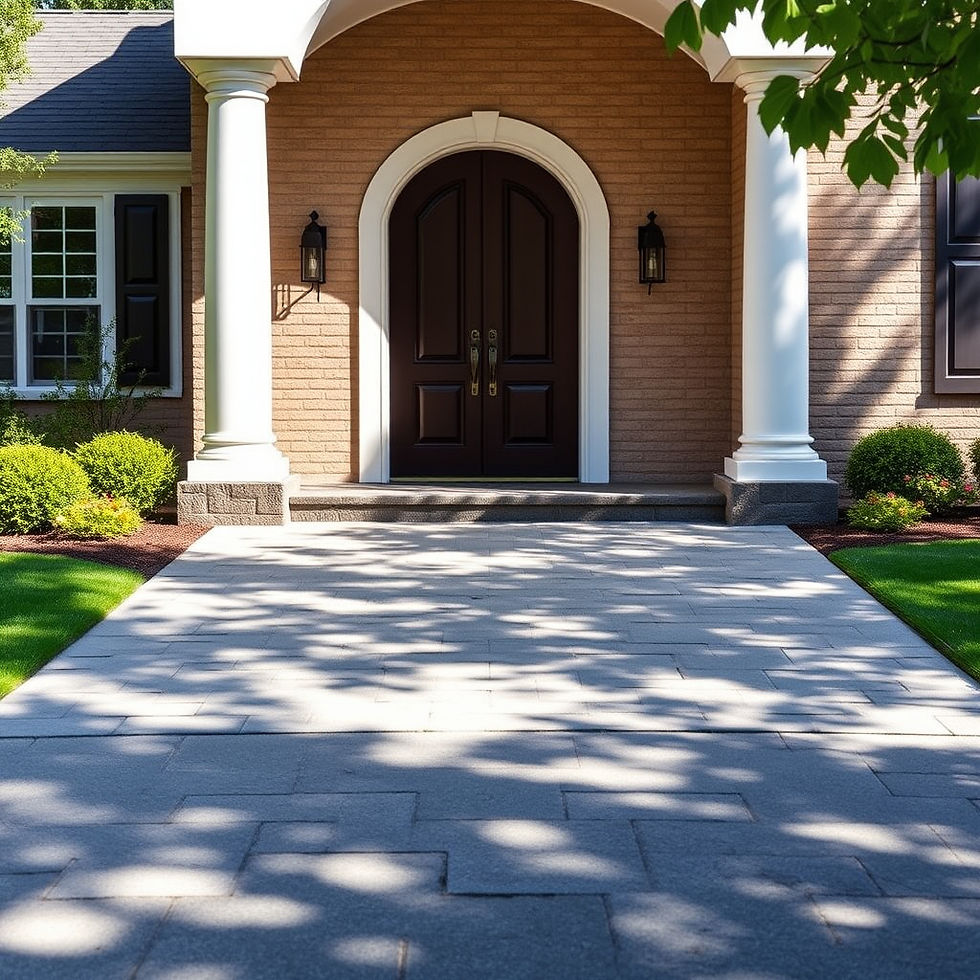Color Drench Your Living Space: The Bold Interior Design Trend That’s Transforming Homes
- Staff Desk
- Aug 14
- 5 min read

Once upon a time, home decorating trends told us to keep our walls neutral, paint the ceiling white, and add “pops of color” in the form of throw pillows or artwork. That era is over. Enter color drenching — an interior design approach that wraps you in a single hue from floor to ceiling, creating a room that feels immersive, cozy, and unapologetically stylish.
In a color-drenched space, the same color is applied to walls, trim, doors, and even the ceiling, often with tonal variations in furniture and decor. This technique doesn’t just decorate a room — it transforms how you experience it. The result? A space that feels intentional, cohesive, and often surprisingly calming despite its boldness.
2. What Exactly Is Color Drenching?
Color drenching is the art of using one dominant color — in varying tones or exactly the same shade — across all major surfaces in a room. While monochrome color schemes have existed for decades, drenching takes it further by painting or finishing the entire space in that color, leaving no white ceiling or contrasting trim to break the visual flow.
Originating in parts of the UK and gaining traction in Europe before becoming a global trend, color drenching began as an antidote to sterile, all-white interiors. Interior designers and homeowners alike craved rooms with personality and mood — and discovered that full immersion in one hue could completely change a room’s energy.
3. The Psychology of Immersive Color
Humans have strong emotional responses to color. By surrounding yourself in a single hue, you amplify that emotional connection. The choice of color becomes more than aesthetic — it becomes atmospheric.
Deep blues promote calm, stability, and focus — perfect for bedrooms or home offices.
Rich greens evoke nature and renewal, making them ideal for living rooms or kitchens.
Warm terracottas and rust tones bring comfort and earthiness, working well in dining rooms.
Soft pinks and blush tones can create warmth and approachability in any room.
Interestingly, drenching in darker tones often makes a room feel cozier, while lighter tones can make it feel spacious yet serene. The absence of contrasting colors keeps the eye from being distracted, helping the mind to relax.
4. Color Drenching vs. Monochrome
While both use a single color family, monochrome schemes typically allow for breaks — a white ceiling, lighter trim, or contrasting furniture. Color drenching eliminates those interruptions, resulting in an enveloping, cocoon-like effect.
Think of it like music:
Monochrome is a melody with a few pauses and changes in key.
Color drenching is a continuous, rich tone that surrounds you fully.
This makes drenching more dramatic, but also more cohesive.
5. The Best Rooms for Color Drenching
While you can color drench any space, some rooms truly shine with this technique:
Living Rooms: Creates a cozy, sophisticated vibe. Great for entertaining or relaxing.
Bedrooms: Ideal for restful retreats; dark tones can make you feel protected, while soft pastels can feel dreamy.
Dining Rooms: Dramatic colors enhance a sense of intimacy, perfect for dinner parties.
Home Offices: Focus-inducing hues like green or blue can improve productivity.
Hallways & Powder Rooms: Small spaces are perfect for experimental colors without overwhelming the home.
6. Choosing Your Palette
The magic of color drenching is that you can go bold or subtle depending on your comfort level.
6.1 Bold Jewel Tones
Emerald green
Sapphire blue
Deep burgundyThese add instant luxury and sophistication.
6.2 Soothing Neutrals
Warm beige
Soft taupe
Greige (grey-beige)Perfect for a minimalist or Scandinavian-inspired home.
6.3 Moody Darks
Charcoal grey
Midnight blue
Forest greenThese can make rooms feel cocoon-like and intimate.
6.4 Bright & Cheerful
Goldenrod yellow
Terracotta orange
Blush pinkThese bring vibrancy and joy to a space.
7. Lighting Considerations
Lighting can make or break a drenched room. Since there are no contrasting colors, light interacts with the hue more dramatically.
Natural Light: Can make colors appear lighter and more open during the day.
Artificial Light: Choose warm bulbs for cozy tones; cool bulbs can make some colors look harsh.
Layered Lighting: Use table lamps, floor lamps, and wall sconces to create depth and avoid flatness.
8. How to Execute Color Drenching
A step-by-step guide to pulling it off at home:
Choose Your Color with Care
Test swatches at different times of day.
View under both natural and artificial lighting.
Prep Your Surfaces
Sand and prime walls, ceiling, and trim for a uniform base.
Paint Everything
Apply the chosen color to walls, ceiling, doors, window frames, and baseboards.
Consider satin or eggshell for walls, semi-gloss for trim.
Select Tonal Furniture
Choose upholstery in slightly lighter or darker shades of the same color.
Add texture to avoid monotony.
Add Layered Textures
Velvet, linen, and natural wood can keep the space dynamic.
9. Furniture and Decor in a Drenched Space
Furniture should complement, not compete with, the drench.
Tonal Layering: Choose slightly different shades of the main color for chairs, sofas, or rugs.
Contrasting Materials: Use wood, metal, or glass to break up large blocks of color without disrupting harmony.
Statement Art: Bold, high-contrast art can pop beautifully against a drenched backdrop.
10. Common Mistakes to Avoid
Picking the Wrong Undertone – Always check how warm or cool your chosen color is; it will dominate the space.
Forgetting the Ceiling – Leaving it white breaks immersion.
Ignoring Lighting – The same color can look entirely different under yellow vs blue light.
Overloading Patterns – Too many patterns can clash with the unified look.
11. Budget-Friendly Color Drenching
You don’t need a huge budget to embrace this trend.
DIY Painting: Labor costs drop dramatically if you paint yourself.
Repurpose Furniture: Repaint old pieces to match your chosen tone.
Affordable Textiles: Cushion covers, curtains, and rugs in matching hues can be found at budget retailers.
12. Real-World Inspiration
Small Apartment, Big Impact: A studio drenched in deep teal felt larger because the continuous color blurred boundaries.
Victorian Terrace Revival: An old dining room in warm terracotta became a showpiece for gatherings.
Modern Minimalist Loft: Pale grey drenching with soft lighting created a serene retreat in the middle of a busy city.
13. Color Drenching for Different Styles
Minimalist: Stick to muted tones and clean lines.
Eclectic: Layer textures, patterns, and tonal variations.
Traditional: Use heritage colors like burgundy or deep navy.
Modern Luxe: Pair jewel tones with metallic finishes.
14. Maintaining a Drenched Room
Cleaning: Use gentle cleaners for painted surfaces.
Touch-Ups: Keep extra paint for scuffs or chips.
Seasonal Accents: Swap throw pillows or art to refresh the space without repainting.
Conclusion: Why Color Drenching Is Here to Stay
Color drenching isn’t just a fleeting Instagram trend — it’s a philosophy of immersion, mood creation, and personal expression. By wrapping your living space in a single hue, you create a feeling that’s hard to achieve with scattered accents or neutral walls.
Whether you choose a soothing sage, a moody navy, or a joyful terracotta, the key is to commit fully. Because when you color drench, you’re not just painting a room — you’re shaping an atmosphere, telling a story, and making a space undeniably yours.



Comments